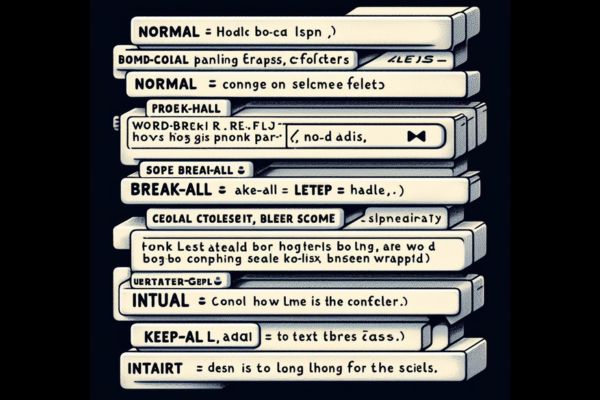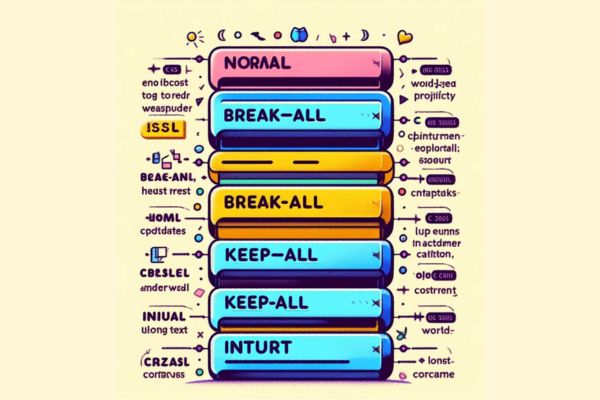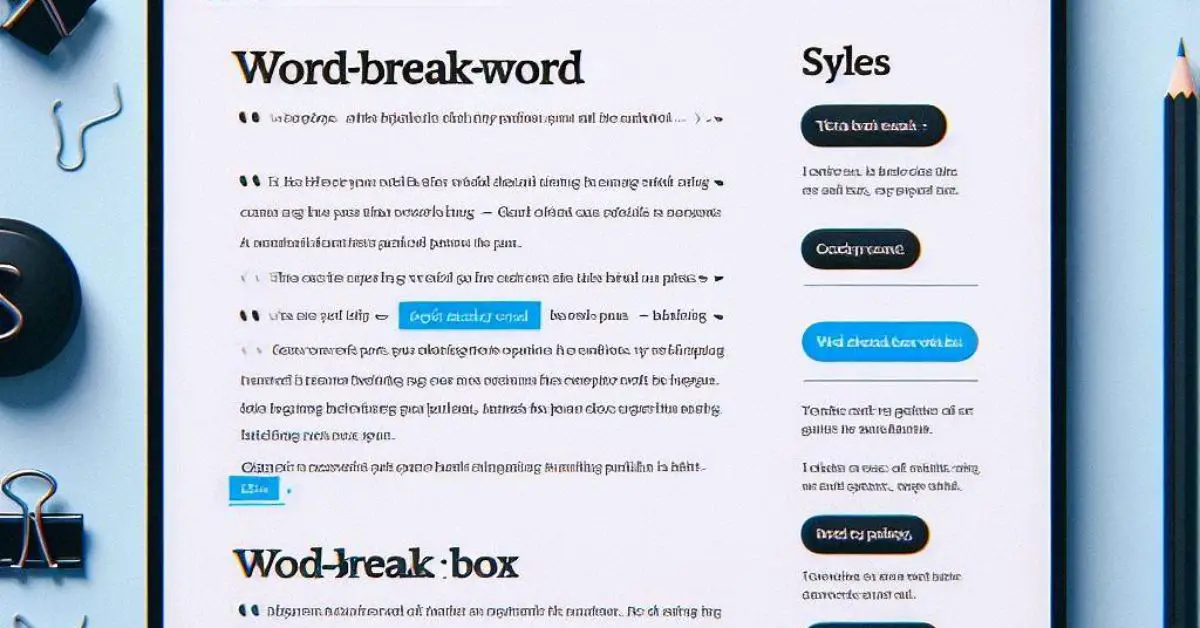Introduction
CSS (Cascading Style Sheets) provides the tools for web developers to shape the layout and look of their websites. One significant, yet often ignored aspect of CSS, is the “word-break” property. Intended to ensure smooth user experience and readability across devices, the word-break property handles long words or strings effectively. In this article, we aim to decode the word-break property and its types - normal, break-all, and keep-all. We'll elaborate on their unique roles and provide practical examples. Additionally, we'll delve into scenarios requiring word break attention, its role in web development, best implementations and upcoming trends. Our target? To help you understand and use the 'word-break' property to create visually pleasing, seamless reading experiences on your web platforms.
Understanding Word Break Property In CSS

The Word-break property in CSS becomes particularly significant when managing long words or text sequences that won't comfortably fit within the confines of a container's determined width, potentially causing design disruption. In essence, this property guides the browser on the appropriate methodology for tackling these scenarios of potential text overflow or awkward breakage. This direction facilitates a smoother user interaction and an aesthetic visual experience. The Word-break property is of even greater importance on smaller screens like mobile devices where display space is limited, enhancing the design's responsiveness. Thus, it promotes a balanced web development environment.
Common Word Break Properties In CSS

word-break: normal
The default value, “normal,” allows the browser to break words at allowed break points, such as spaces and hyphens. This ensures that text remains readable and flows naturally.
When a word is too long to fit within a line, the browser will automatically break it at a suitable point to prevent the text from overflowing. This is especially important for responsive design, where the layout adjusts to different screen sizes. By allowing the browser to break words at appropriate points, we can ensure that the content remains accessible and easy to read on any device.
.example {
word-break: normal;
}word-break: break-all
This property breaks words at any point, even within the characters. It’s particularly useful when dealing with long URLs or strings, preventing them from overflowing their containers.
By applying the “word-break: break-all” property, you ensure that the content is displayed in a way that is both visually appealing and functional. This property breaks words without considering any linguistic rules, which means that it can break words in the middle of characters if necessary.
For example, imagine you have a container with a fixed width that needs to display a long URL. Without the “word-break: break-all” property, the URL would overflow the container and potentially disrupt the layout of your webpage. However, by applying this property, the URL will be broken at any point necessary to fit within the container, ensuring that the layout remains intact.
.example {
word-break: break-all;
}word-break: keep-all
The CSS property “word-break: keep-all” is particularly useful when dealing with languages that use ideographic characters, such as Chinese and Japanese. This property prevents breaks between ideographic characters, ensuring that the text remains cohesive and maintains its intended meaning.
In languages like Chinese and Japanese, where characters are often combined to form words or phrases, it is important to keep the characters together to maintain readability and comprehension. By using “word-break: keep-all,” you can ensure that the text is displayed as intended, without any unwanted breaks that could disrupt the flow of the content.
For example, imagine a sentence in Chinese that consists of several ideographic characters. Without the “keep-all” property, the text might be broken at inappropriate places, leading to confusion and misinterpretation. However, by applying “word-break: keep-all,” you can ensure that the characters are displayed together, preserving the integrity of the sentence.
Overall, “word-break: keep-all” is a valuable CSS property for maintaining the cohesion and readability of text in languages that rely heavily on ideographic characters. By preventing breaks between these characters, you can ensure that the text remains clear and understandable, enhancing the overall user experience.
.example {
word-break: keep-all;
}Situations Demanding Word Break

Responsive Design Challenges
In the era of responsive web design, accommodating various screen sizes and orientations is paramount. Word break property becomes indispensable in preventing long words from causing layout distortions on smaller screens.
7 types of web design, How to make?
Multilingual Content Considerations
For websites catering to a global audience, multilingual content is common. Word-break Property helps maintain the integrity of text in different languages, preventing awkward breaks that might hinder comprehension.
Implementation in Web Development

Applying Word Break Property in HTML
Implementing word break in CSS is a straightforward process. Simply apply the desired property to the relevant HTML element or class, and the browser will handle the rest. It’s a simple yet effective way to control text behavior.
<div class="example">
This is a long piece of text that needs proper word breaking.
</div>Browser Compatibility
Browser compatibility is an important factor to consider when using the word break property in CSS. Although most modern browsers support this property, it is still necessary to conduct thorough testing to ensure a consistent experience across different platforms.
Ensuring browser compatibility is essential for providing a seamless user experience. When users access a website or application, they expect it to function properly regardless of the browser they are using. By testing the word break property on various browsers, you can identify any potential issues or inconsistencies that may arise.
Different browsers may interpret the word break property differently, leading to variations in how text is displayed and wrapped. By conducting comprehensive testing, you can ensure that the word break property behaves consistently across different browsers, preventing any unexpected layout or readability issues.
In addition to testing on different browsers, it is also important to consider compatibility with different versions of the same browser. Older versions of browsers may not fully support the word break property or may have different default behaviors. By testing on multiple versions, you can identify any compatibility issues and implement appropriate fallback solutions if needed.
In conclusion, browser compatibility is a crucial aspect to consider when using the word break property in CSS. Thorough testing on different browsers and versions can help ensure a consistent and optimal user experience across various platforms.
Best Practices for Word Break property
Balancing Readability and Design
Achieving the right balance between readability and design is key. While preventing overflow is essential, it’s equally important to maintain the readability of the text. Testing with different scenarios helps strike the right balance.
Testing and Debugging Techniques
Testing and debugging techniques are crucial when it comes to incorporating word break in CSS. To ensure a seamless user experience, developers should take the time to thoroughly test their code and address any issues related to word breaks.
One effective testing technique is to utilize browser developer tools. These tools allow developers to inspect and manipulate the HTML and CSS of a webpage in real-time. By using the element inspector, developers can identify any elements that may be causing word break issues and make necessary adjustments to the CSS.
Another important aspect of testing is to check the webpage on various devices. Different devices and screen sizes can affect how word breaks are displayed. By testing on multiple devices, developers can ensure that their code is responsive and that word breaks are handled correctly across different platforms.
In addition to testing, debugging techniques can also be employed to identify and fix any issues related to word breaks. One common debugging technique is to use console.log statements in JavaScript to output relevant information about word breaks. This can help developers pinpoint the source of the issue and make the necessary changes to the code.
By incorporating thorough testing and utilizing debugging techniques, developers can ensure that word breaks are handled correctly in CSS. This will result in a better user experience and prevent any issues related to word breaks on different devices and screen sizes.
Future Trends in Word Break Property

Testing and debugging techniques play a crucial role in ensuring the effectiveness of the word break property in CSS. By thoroughly testing and debugging, developers can identify and resolve any issues related to word breaking in different scenarios.
One important technique is to test the word break property across various browsers and devices. This helps ensure consistent behavior and compatibility across different platforms. By testing on popular browsers such as Chrome, Firefox, and Safari, developers can identify any inconsistencies or bugs that may arise.
Another technique is to test the word break property with different types of content. This includes testing with long paragraphs, headings, lists, and tables. By doing so, developers can ensure that the word break property functions as expected in different content structures.
Additionally, it is important to test the word break property with different languages and character sets. This includes testing with languages that have unique word breaking rules, such as Chinese or Japanese. By doing so, developers can ensure that the word break property handles different languages accurately.
When debugging, developers can use browser developer tools to inspect the applied styles and identify any issues. By examining the CSS rules and the rendered output, developers can pinpoint any errors or unexpected behavior related to word breaking.
In conclusion, testing and debugging techniques are essential for ensuring the proper functionality of the word break property in CSS. By thoroughly testing across browsers, devices, content types, and languages, and using debugging tools, developers can ensure a seamless user experience with word breaking in diverse scenarios.
Conclusion
In conclusion, word break property is a subtle yet powerful feature that addresses common challenges in web typography. By understanding its properties, implementing best practices, and staying abreast of future trends, web developers can ensure a seamless and visually pleasing reading experience for users.
FAQs
1. Is word break property supported in all browsers?
Yes, most modern browsers support word break property. However, it’s recommended to test across different browsers for optimal compatibility.
2. Can word break property be applied selectively to specific elements?
Absolutely. You can apply word break property to specific HTML elements or classes, allowing for targeted control over text behavior.
3. How does word break property impact SEO?
Word break property itself doesn’t directly impact SEO. However, ensuring a clean and readable layout indirectly contributes to a positive user experience, which can influence SEO rankings.
4. Are there alternatives to word break property for handling long words?
Yes, alternatives like adjusting font size, line height, or utilizing ellipsis (…) for overflow are common. word break property offers a versatile solution depending on the specific use case.
5. Does word break Property work for non-Latin scripts?
- Absolutely. word break property is designed to handle various languages, including non-Latin scripts like Chinese, Japanese, and Arabic, ensuring proper text display.
CSS Position Property: A Professional Guide




